Results released for Queensland field trials
Six large-scale field trials have been established on dieback-affected commercial grazing properties in southern and central Queensland at Yerra, Biggenden, the Biloela region and Middlemount.
Trials were set up between January and March 2018* to test the effectiveness of a range of interventions aimed at controlling pasture dieback. Trials included:
- cultivation
- re-sowing with pasture and legume mixes (which are potentially resistant to dieback)
- burning
- fertiliser applications (MAP, DAP, Urea)
- grazing/slashing
- combinations of the above treatments.
While the cause of dieback has yet to be identified, some of these field treatments are showing promise in producing good pasture biomass. As at June 2018, there have not been signs of dieback recurring.
Rainfall has been low across most of the trial sites, and as the reserves of soil moisture declined, the pastures are dormant due to lack of water.
It’s not yet known if dieback will re-appear in the trials, especially when the first rain generally occurs in spring. However, for producers who are seeking guidance on trial options for their own properties, the results of field trials described below could provide some indication.
Re-sowing dieback-affected areas with pasture grasses
In the northern region of central Queensland, cultivating and re-sowing pasture with Callide and Reclaimer Rhodes grass (Chloris gayana) is working well with good germination, biomass and no signs of dieback as at June 2018. Re-sown Gayndah or American buffel has established well where there was no buffel previously, with no sign of dieback to date.
In the southern trials sites around Yerra, Tully grass (Urochloa humidicola) has been trialled and may be resistant to dieback. Other promising pasture species in the southern region include Callide Rhodes grass, Splenda setaria and Signal grass. Biloela buffel also appears to be less susceptible to pasture grass dieback than Gayndah or American buffel and could be considered for re-sowing.
Note:
Seed treatments. All re-sown pasture and legume seed was coated and contained the insecticide Poncho™. There is also a seed dressing EverGol Xtend™ (Bayer) which is registered for pastures and legumes, and may give some protection against soil-borne diseases. Both treatments can be applied by your seed supplier.
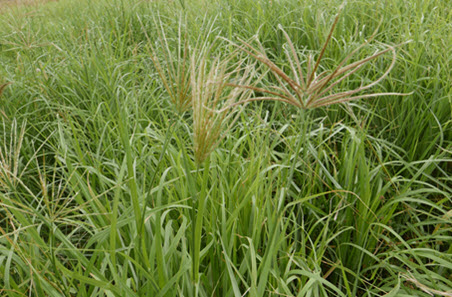
Re-sown Callide and Reclaimer Rhodes grass (Photo taken 5 May 2018).
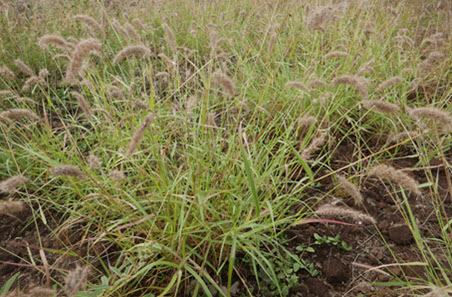
Re-sown buffel that has established and no sign of dieback (Photo taken 5 May 2018).
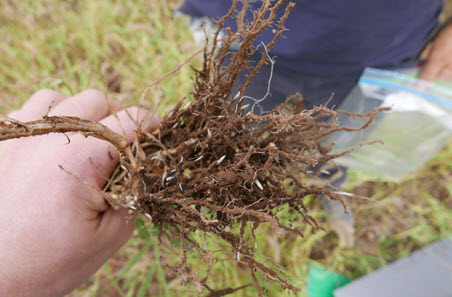
A root system from a healthy re-sown buffel plant with healthy white growing tips (Photo taken 5 May 2018).
Re-sowing dieback-affected areas with legumes
Cultivating and re-sowing pasture with legumes have established well in all regions with no signs of dieback as at June 2018. Legumes varieties used were Highworth Lablab (Lablab purpureus), Marc Desmanthus (Desmanthus virgatus), Butterfly pea (Clitoria ternatea) and Burgundy bean (Macroptilium bracteatum). Legume seeds were inoculated with the correct strain of Rhizobium bacteria before sowing.

Lablab established on a trial site with no signs of dieback (Photo taken 14 April 2018).
Re-sowing dieback-affected areas with a mix of legumes and pasture grasses
Re-sowing with a mixture of pasture and legumes has also been effective so far, with no sign of dieback as of June 2018. Some effective mixes have been:
- Butterfly pea, Lablab, Desmanthus and Callide and Reclaimer Rhodes grass, plus fertiliser
- Buffel grass, Lablab, Butterfly pea and Desmanthus.
Re-sowing with either pasture or with legume mixes has resulted in much greater pasture growth when combined with added fertiliser (75 or 150kg/ha DAP or MAP). Sorghum has not been affected by dieback.
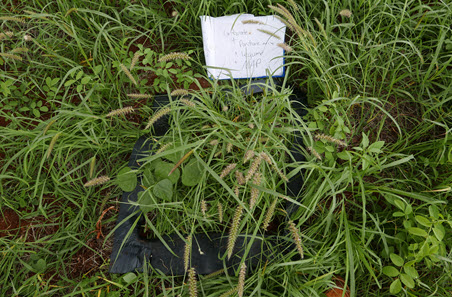
A mixture of lablab, butterfly pea and buffel grass in the burn-cultivate, re-seed, fertiliser treatment (Photo taken 7 March 2018).
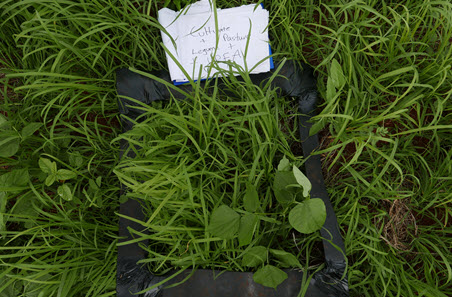
A mixture of lablab, butterfly pea and Rhodes grass in the cultivate, re-seed, fertiliser treatment (Photo taken 7 March 2018).
More information
Dr Gordon Rogers
Applied Horticultural Research
Email Dr Gordon Rogers
M: 0418 517 777



